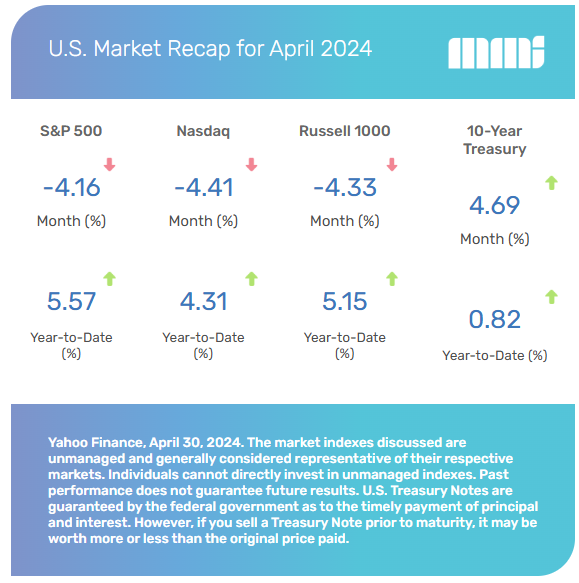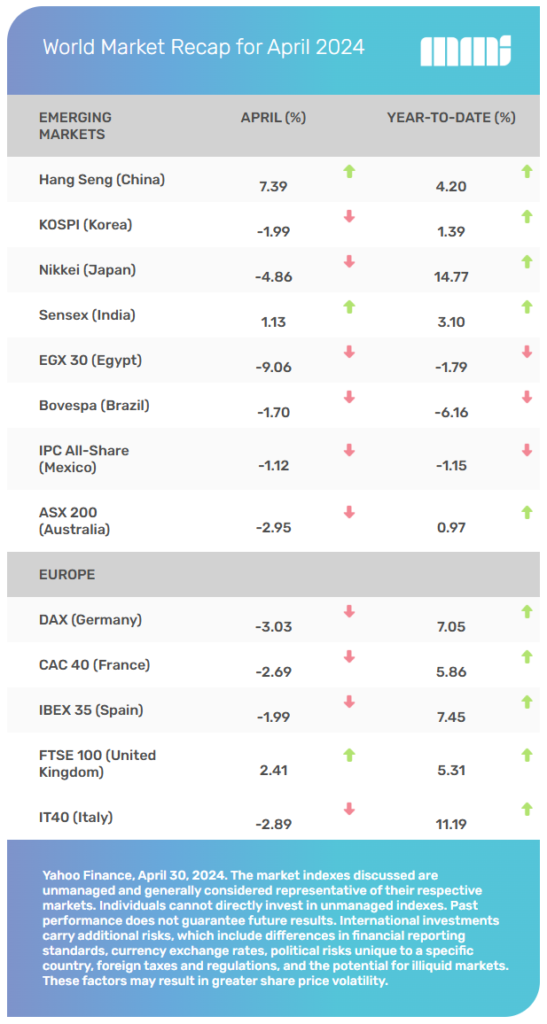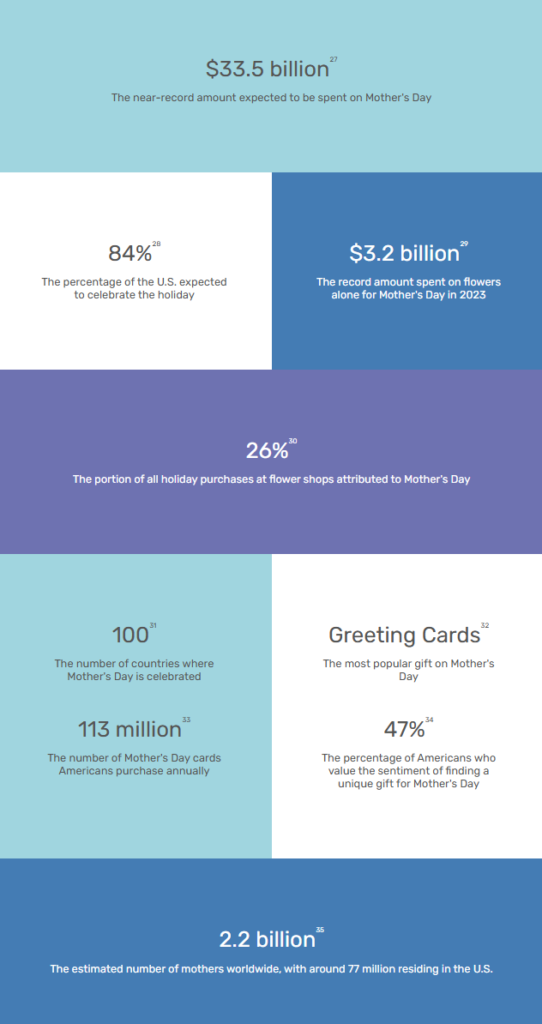U.S. Markets
Despite a late-month rally, stocks fell in April as investors struggled with a hotter-than-expected inflation report and mixed news about the economy.
The Dow Jones Industrial Average dropped 5.00 percent, while the Standard & Poor’s 500 Index declined 4.16 percent. The tech-heavy Nasdaq Composite fell 4.41 percent. [1]
Mixed Economic Data
Economic data out early in the month unnerved investors, and conflicting comments from Fed officials regarding future rate moves exacerbated the selling pressure. Better-than-expected jobs data for the week buoyed markets, but sellers had the upper hand as trading got underway. [2,3]
Stubborn Inflation
Markets continued lower the following week when fresh Consumer Price Index data showed that March inflation was hotter than expected. Bond yields rose, and stocks retreated in response. Stocks breathed a sigh of relief when the wholesale inflation report, released the following day, was less than the consensus estimate. [4,5,6]
Mixed Signals from the Fed
Remarks from Fed Chair Jerome Powell also unsettled traders, as his tone appeared to shift from confident to not-so-confident about interest rate cuts. A stronger-than-expected retail sales report was one of the few bright spots among the economic reports. It suggested that consumers were spending despite rising inflation. [7,8]
Middle East Tensions
Tensions in the Middle East influenced trading throughout the month. Despite the headwinds, stocks pushed higher in the final full week of trading as upbeat Q1 reports from two mega-cap tech stocks emboldened investors. But the short-term rally gave way to selling as the month came to a close. [9,10,11]
Sector Scorecard
Utilities (+1.66 percent) was the only sector that ended the month above water. Real Estate (8.45 percent), Health Care (-5.01 percent), Technology (-5.76 percent), and Communications Services (-4.64 percent) led the declines. Financials (-4.18 percent), Materials (-4.59 percent), Consumer Discretionary (-4.50 percent), and Industrials (-3.56 percent) were also under pressure. Consumer Staples fell 1.13 percent, and Energy lost 0.94 percent. [12]

What Investors May Be Talking About in May
The Fed’s two-day policy meeting ended on May 1, but if March is any indication, the “headline-grabbing” comments from Fed officials won’t start until a few days after the Fed’s official meeting concludes.
Federal Reserve policy limits the extent to which Federal Open Market Committee (FOMC) participants and staff can speak publicly or grant interviews during Federal Reserve blackout periods, which begin the second Saturday preceding a FOMC meeting and end the Thursday following a meeting unless otherwise noted.
Starting on May 2, Federal Reserve governors and presidents are allowed to schedule speaking events. During the speeches, they are allowed to give their personal perspectives on the economy, inflation, and interest rates. Last month, several speeches showed a divided Fed regarding what’s next with interest rates.
When the Fed’s official meeting ended on March 20, the formal Fed statement said officials had penciled in three quarter-point cuts in short-term rates by the end of 2024. But a short time later, Fed officials started to tell a different story. Atlanta Fed President Raphael Bostic suggested one interest rate cut, followed a few days later by Minneapolis President Neel Kashkari saying that cuts may be off the table entirely. [13,14]
So, while the markets digest the Fed’s official statement on May 1, they also anticipate what Fed officials will say in the coming weeks.
World Markets
The MSCI EAFE Index fell 2.93 percent in April. [15]
In continental Europe, there were more markets in the red than in the green. Germany (-3.11 percent), Italy (-2.89 percent), France (-2.69 percent), and Spain (-1.99 percent) trended lower for the month. Meanwhile, the U.K. notched a gain, picking up 2.42 percent. [16]
The Pacific Rim markets were also mixed. Hong Kong rose 7.39 percent, while Japan dropped 4.86 percent, and Korea lost 1.99 percent. Australia also was under pressure, slipping 2.95 percent. [17]
Indicators
Gross Domestic Product (GDP)
The U.S. economy grew at 1.6 percent in Q1, below economists’ expectations of 2.4 percent. Taking a deeper look, a slowdown in spending on goods, along with shifts in inventories and international trade on the business side, were primary reasons for the disappointing number. [18]
Employment
Employers added 303,000 jobs in March, topping the 200,000 expected by economists. The unemployment rate edged down to 3.8 percent, in line with expectations, while average hourly earnings increased 0.3 percent and 4.1 percent, also as expected. [19]
Retail Sales
Consumer spending rose 0.7 percent in March, more than double the 0.3 percent increase expected. [20]
Industrial Production
Industrial output rose 0.4 percent in March in line with estimates. [21]
Housing
Housing starts rose by 8.8 percent in March compared with February and 8.3 percent from March 2023. [22
Existing home sales dropped 4.3 percent. Some speculated the new rules around agent commissions seem to have many prospective homebuyers sitting on the sidelines. March sales were down 3.7 percent on a year-over-year basis. The median sales price was up 4.8 percent from a year earlier, to $393,500. [23]
Consumer Price Index (CPI)
Consumer prices rose 0.4 percent in March over the previous month and 3.5 percent compared with a year prior. Both monthly and 12-month increases were hotter than expected. Core prices, which exclude food and energy, rose 0.4 percent on a monthly basis and 3.8 percent year-over-year. [24]
Durable Goods Orders
Orders of manufactured goods designed to last three years or longer rose 2.6 percent in March, compared with a 0.7 percent increase in February. [25]
The Fed
Minutes from the March FOMC meeting, released on April 10, showed officials’ concern that inflation wasn’t slowing down quickly enough toward the Fed’s 2 percent target.
They reiterated that rate cuts were still on the table for this year. The Fed funds rate remains at the 5.25–5.50 percent target range as of the end of April. Investor attention will shift to indicators following the Fed’s decision at its April 30–May 1 meeting. [26]
By the Numbers: May is for the Mothers

Lighthouse Financial, LLC may be reached at www.lighthousefinancialllc.com, 303-444-1818 or wisdom@lighthousefinancialllc.com.
Investment and Advisory services are provided by Petra Financial Advisors, Inc., headquartered at 2 N. Nevada Ave. Suite 1300, Colorado Springs, CO 80903.
The content is developed from sources believed to be providing accurate information. The information in this material is not intended as tax or legal advice. Please consult legal or tax professionals for specific information regarding your individual situation. This material was developed and produced by FMG Suite to provide information on a topic that may be of interest. FMG Suite, LLC, is not affiliated with the named representative, broker-dealer, or state- or SEC-registered investment advisory firm. The opinions expressed and material provided are for general information and should not be considered a solicitation for the purchase or sale of any security.
Investing involves risks, and investment decisions should be based on your own goals, time horizon and tolerance for risk. The return and principal value of investments will fluctuate as market conditions change. When sold, investments may be worth more or less than their original cost.
Any companies mentioned are for illustrative purposes only. It should not be considered a solicitation for the purchase or sale of the securities. Any investment should be consistent with your objectives, timeframe, and risk tolerance.
The forecasts or forward-looking statements are based on assumptions, subject to revision without notice, and may not materialize.
The market indexes discussed are unmanaged and generally considered representative of their respective markets. Individuals cannot directly invest in unmanaged indexes. Past performance does not guarantee future results.
The Dow Jones Industrial Average is an unmanaged index that is generally considered representative of large-capitalization companies on the U.S. stock market. The S&P 500 Composite Index is an unmanaged group of securities considered to be representative of the stock market in general. The Nasdaq Composite is an index of the common stocks and similar securities listed on the Nasdaq stock market and considered a broad indicator of the performance of stocks of technology and growth companies. The Russell 1000 Index is an index that measures the performance of the highest-ranking 1,000 stocks in the Russell 3000 Index, which is comprised of 3,000 of the largest U.S. stocks. The MSCI EAFE Index was created by Morgan Stanley Capital International (MSCI) and serves as a benchmark for the performance in major international equity markets, as represented by 21 major MSCI indexes from Europe, Australia, and Southeast Asia. Index performance is not indicative of the past performance of a particular investment. Past performance does not guarantee future results. Individuals cannot invest directly in an index. The return and principal value of stock prices will fluctuate as market conditions change. And shares, when sold, may be worth more or less than their original cost.
International investments carry additional risks, which include differences in financial reporting standards, currency exchange rates, political risks unique to a specific country, foreign taxes and regulations, and the potential for illiquid markets. These factors may result in greater share price volatility.
The Hang Seng Index is a benchmark index for the blue-chip stocks traded on the Hong Kong Stock Exchange. The KOSPI is an index of all stocks traded on the Korean Stock Exchange. The Nikkei 225 is a stock market index for the Tokyo Stock Exchange. The SENSEX is a stock market index of 30 companies listed on the Bombay Stock Exchange. The Jakarta Composite Index is an index of all stocks that are traded on the Indonesia Stock Exchange. The Bovespa Index tracks 50 stocks traded on the Sao Paulo Stock, Mercantile, & Futures Exchange. The IPC Index measures the companies listed on the Mexican Stock Exchange. The MERVAL tracks the performance of large companies based in Argentina. The ASX 200 Index is an index of stocks listed on the Australian Securities Exchange. The DAX is a market index consisting of the 30 German companies trading on the Frankfurt Stock Exchange. The CAC 40 is a benchmark for the 40 most significant companies on the French Stock Market Exchange. The Dow Jones Russia Index measures the performance of leading Russian Global Depositary Receipts (GDRs) that trade on the London Stock Exchange. The FTSE 100 Index is an index of the 100 companies with the highest market capitalization listed on the London Stock Exchange.
Please consult your financial professional for additional information.
Copyright 2024 FMG Suite.
- WSJ.com, April 30, 2024
- WSJ.com, April 4, 2024
- WSJ.com, April 5, 2024
- CNBC.com, April 10, 2024
- WSJ.com, April 11, 2024
- WSJ.com, April 11, 2024
- CNBC.com, April 15, 2024
- WSJ.com, April 16, 2024
- CNBC.com, April 21, 2024
- CNBC.com, April 23, 2024
- WSJ.com, April 25, 2024
- SectorSPDR.com, April 30, 2024
- CNBC.com, April 5, 2024
- Reuters.com, April 10, 2024
- MSCI.com, April 30, 2024
- MSCI.com, April 30, 2024
- MSCI.com, April 30, 2024
- WSJ.com, April 15, 2024
- CNBC.com, April 5, 2024
- CNBC.com, April 15, 2024
- CNBC.com, April 16, 2024
- Census.gov, April 23, 2024
- Reuters.com, April 18, 2024
- CNBC.com, April 10, 2024
- BankingJournal.aba.com, April 24, 2024
- FederalReserve.gov, April 10, 2024
- NationalRetailFederation, 2024
- NationalRetailFederation, 2024
- Oberlo.com, 2024
- FinanceBuzz.com, April 11, 2024
- FinanceBuzz.com, April 11, 2024
- FinanceBuzz.com, April 11, 2024
- FinanceBuzz.com, April 11, 2024
- FinanceBuzz.com, April 11, 2024
- FinanceBuzz.com, April 11, 2024
